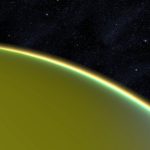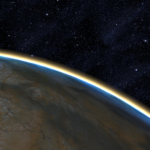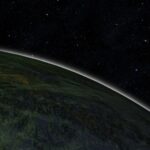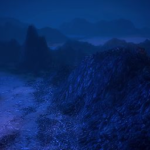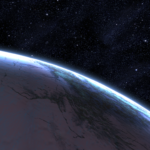System Specs:
- Stellar Mass: 0.4 Sol Masses
- Stellar Class: M V
- Luminosity: 0.04 Sol
- Planets: 4
- Moons: 0
- Asteroid Belts: 0
- Asteroids: 0
- Objects: 0

Fortuna is a red dwarf. Its name is Latin for “fate”, “fortune” or “luck” and is used as the proper name of the Roman goddess of fortune and fate.
The Fortuna system was initially charted by the Alliance starship Kupe, though only a small probe could be spared for Wentania. One of her crewmen was the poet Sofia Cabral, who was aboard during her tour of duty with the Alliance and who named the planet Amaranthine. Kupe is named after the Polynesian who — according to some Maori mythologies — discovered Aotearoa (New Zealand).
–
Planets Directory:
- Maganlis
- Therumlon
- Amaranthine
- Wentania
–
Maganlis:
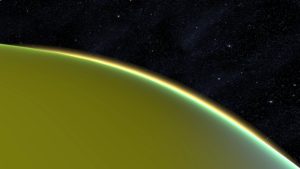
- Orbital Distance: 1.32 AU
- Orbital Period: 2.4 Earth-years
- Keplerian Ratio: 0.399
- Radius: 7,708 km
- Day Length: 33.2 Earth-hours
- Atmospheric Pressure: 1.03 atm
- Surface Temp: −150 °C
- Surface Gravity: 1.1 g
- Mass: 1.595 Earth-masses
Maganlis is a rock terrestrial with an atmosphere of sulphur dioxide and trace amounts of helium. Scans reveal ancient lava plains on the surface, implying a geologically active past. The crust consists of sulphur and basalts, but the planet’s mass suggests a core of iron and heavier materials. Cursory drill coring suggests the possibility of simple subterranean life.
Survey Text
“While scanning the planet Maganlis, you discovered the remains of a damaged research vessel. Your recon team found no signs of survivors, but they did bring back a Rocam Outpost insignia.”
–
Therumlon:
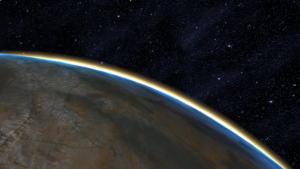
- Orbital Distance: 7.33 AU
- Orbital Period: 31.4 Earth-years
- Keplerian Ratio: 0.399
- Radius: 5,492 km
- Day Length: 69.0 Earth-hours
- Atmospheric Pressure: 17.11 atm
- Surface Temp: −134 °C
- Surface Gravity: 0.7 g
- Mass: 0.515 Earth-masses
Therumlon is a frigid world with a thick nitrogen-argon atmosphere. The crust contains silicates and unremarkable ores, but is surprisingly rich in phosphates. Since the atmosphere lacks free oxygen, the phosphates are relatively pure and could be of value in the manufacture of fertilizer and incendiary ammunition.
–
Amaranthine:
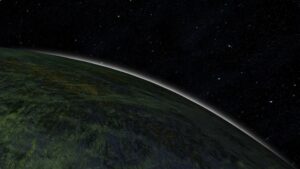
- Orbital Distance: 3.86 AU
- Orbital Period: 12.0 Earth-years
- Keplerian Ratio: 0.399
- Radius: 6,694 km
- Day Length: 59.7 Earth-hours
- Atmospheric Pressure: 1.19 atm
- Surface Temp: −178 °C
- Surface Gravity: 1.16 g
- Mass: 1.268 Earth-masses
- Satellites: 1
Amaranthine is a chilly rock world with an atmosphere of carbon dioxide and nitrogen. Its frozen surface consists largely of light titanium and aluminum oxides, with deposits of thorium and other heavy metals located in the deep crust. Amaranthine was named by the human poet Sofia Cabral during her tour of duty aboard the Alliance surveyor ship Kupe. Under the dim light of the red dwarf Fortuna, the surface of this world is lit in rich twilight blues and purples even at midday.
–
Wentania:

- Orbital Distance: 13.93 AU
- Orbital Period: 82.2 Earth-years
- Keplerian Ratio: 0.4
- Radius: 3,198 km
- Day Length: 32.5 Earth-hours
- Atmospheric Pressure: 0.03 atm
- Surface Temp: −237 °C
- Surface Gravity: 0.2 g
- Mass: 0.05 Earth-masses
Hard data on Wentania is very limited. When the system was charted by the Alliance surveyor Kupe, only a small, unmanned flyby probe was spared for the distant world. It is a small rock and ice planet, with a trace atmosphere of krypton and sulfur dioxide. Normandy’s more detailed survey suggests the frozen terrestrial may be a suitable target for mining. While it is largely water ice, mapping of mass concentrations suggests it has a core of pure aluminum.
–
–
video

